Learning
5.0(5)
5.0(5)
Card Sorting
1/70
Study Analytics
Name | Mastery | Learn | Test | Matching | Spaced | Call with Kai |
|---|
No study sessions yet.
71 Terms
1
New cards
Learning
a semi-permanent change in behavior due to experience
2
New cards
Classical Conditioning
Learning to associate a random stimulus to a reflex
“learning is making associations”
“learning is largely reflexive”learning
“learning is making associations”
“learning is largely reflexive”learning
3
New cards
Unconditioned Stimulus (US)
stimulus that naturally produces a response
4
New cards
Unconditioned Response (UCR)
a natural response
5
New cards
naturally feeling pain when pricked with a pin
an example of a UR
what happens when you get pricked with a pin?
what happens when you get pricked with a pin?
6
New cards
UR
dogs salivating naturally
7
New cards
US
meat
8
New cards
Neutral Stimulus (NS)
a stimulus that doesn’t produce a response (pavlov’s bell, at first)
9
New cards
Conditioned Stimulus (CS)
the action paired with the unconditioned stimulus (US) so it eventually changes from the NS to the _____ after the acquisition period
ex. Pavlov ringed a bell at the same time as presenting meat to dog so it associates the 2
ex. Pavlov ringed a bell at the same time as presenting meat to dog so it associates the 2
10
New cards
Conditioned Response (CR)
Trained response to an originally neutral stimulus (which now is the CS)
ex. dogs drooling after associating bell and meat
ex. dogs drooling after associating bell and meat
11
New cards
Acquisition
when the US and the CS are presented together to produce CR
AKA the period of time where a CR is learned
AKA the period of time where a CR is learned
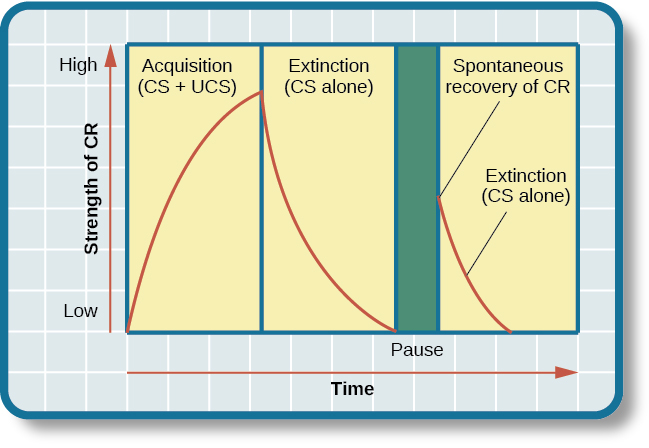
12
New cards
Extinction
when CR stops because the CS hasn’t been presented with the US for a while (it diminishes over time)
ex. dogs stop salivating because you rang the bell without the meat for like the 10th time
ex. dogs stop salivating because you rang the bell without the meat for like the 10th time

13
New cards
Spontaneous Recovery
when the CS produces CR after behavior has been extinct after a short pause
ex. dogs salivating for the 11th time when you ring the bell
(extinction only __suppresses__ CR rather than eliminating it completely)
ex. dogs salivating for the 11th time when you ring the bell
(extinction only __suppresses__ CR rather than eliminating it completely)
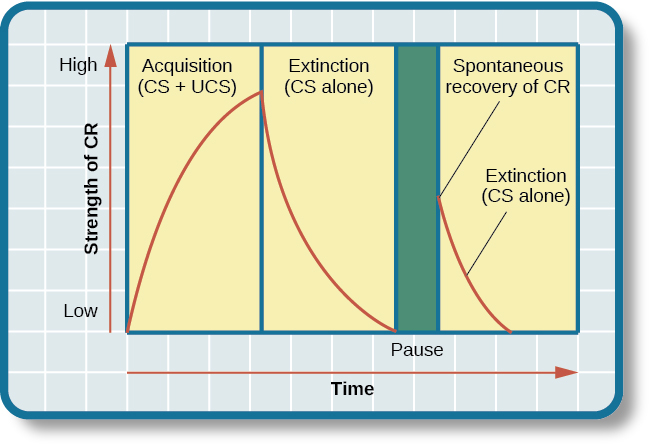
14
New cards
CS
What does the NS become after the acquisition period?
15
New cards
CR
What does the UCR become after the acquisition period?
16
New cards
UCS
before learning, the NS must be paired with the __ to produce the UCR
17
New cards
CR
after learning, the CS induces __?
18
New cards
Contiguity Explanation for Classical Conditioning
“classical conditioning happens because the NS and the UCS happen at the same time (they overlap/touch)”
ex. Pavlov
(but it’s kinda obsolete now, everyone believes in contingency theory now)
ex. Pavlov
(but it’s kinda obsolete now, everyone believes in contingency theory now)
19
New cards
Contingency Explanation for Classical Conditioning
“CC happens because the UCS __depends__ on the NS”
AKA (the NS *predicts* the UCS)
\
ex. you ring bell (NS), wait some time, and the dogs *still* respond (the NS and the UCS don’t have to overlap/touch/happen at the same time)
AKA (the NS *predicts* the UCS)
\
ex. you ring bell (NS), wait some time, and the dogs *still* respond (the NS and the UCS don’t have to overlap/touch/happen at the same time)
20
New cards
Biological Predisposition
What an animal can or can’t do impacts their ability to classically condition them
\+
The senses that an animal relies on the most is going be the best neutral stimulus to classically condition them with
\+
The senses that an animal relies on the most is going be the best neutral stimulus to classically condition them with
21
New cards
Taste Aversion
John Garcia studied ___?
22
New cards
Children had a bad habit of sucking thumbs (the bad habit = NS)
Put bad-tasting lemon juice (UCS) which produced a a natural reaction “EW!” (UCR)
\
So sucking thumbs (NS) became a CS which produced an aversion to the bad taste “EW!” (CR)
Put bad-tasting lemon juice (UCS) which produced a a natural reaction “EW!” (UCR)
\
So sucking thumbs (NS) became a CS which produced an aversion to the bad taste “EW!” (CR)
Example of Taste Aversion:
23
New cards
Little Albert Experiment (by Watson and Raynor)
previously-liked white rat (NS) + fearful noise (UCS) = fear response (UCR)
24
New cards
Conditioned emotional responses
any negative emotional response, typically fear or anxiety, that becomes associated with a neutral stimulus as a result of classical conditioning
25
New cards
Phobia
____ develops as a result of having a negative experience or panic attack related to a specific object or situation
\
an overwhelming and debilitating fear of an object, place, situation, feeling or animal.
\
an overwhelming and debilitating fear of an object, place, situation, feeling or animal.
26
New cards
Superstitions
an irrational belief in the significance or magical efficacy of certain objects or events
ex. omens, lucky charms
ex. omens, lucky charms
27
New cards
Aversion Therapy
used to help a person give up a behavior or habit by having them associate it with something unpleasant.
__ex. ____ ______is most known for treating people with addictive behaviors, like those found in alcohol use disorder.
ex. putting lemon juice on thumbs to stop children from sucking them
__ex. ____ ______is most known for treating people with addictive behaviors, like those found in alcohol use disorder.
ex. putting lemon juice on thumbs to stop children from sucking them
28
New cards
Higher-Order Conditioning
(AKA second-order conditioning)
(AKA second-order conditioning)
procedure in which the conditioned stimulus of one experiment acts as the unconditioned stimulus of another, for the purpose of conditioning a neutral stimulus
\
* tends to be weaker than initial conditioning
ex. guard dog makes us afraid because of getting a dog bite, THEN, hearing a dog bark also may make us afraid
(different than stimulus generalization because the new stimulus is not similar to the original stimulus)
\
* tends to be weaker than initial conditioning
ex. guard dog makes us afraid because of getting a dog bite, THEN, hearing a dog bark also may make us afraid
(different than stimulus generalization because the new stimulus is not similar to the original stimulus)
29
New cards
Behaviorism
a key idea of __this psychological approach__:
“observable behaviors are more important than inner experiences or mental processes”
“observable behaviors are more important than inner experiences or mental processes”
30
New cards
Stimulus Generalization
extending fear-related behaviors of conditioned stimulus to *anything that is similar*
ex. Little Albert being afraid of anything that resembled a white rat after acquisition period
ex. Little Albert being afraid of anything that resembled a white rat after acquisition period
31
New cards
Stimulus Discrimination
ability to tell the difference and only respond to the conditioned stimulus but not other stimuli
32
New cards
Operant (Instrumental) Conditioning
“Learning is based on behavior and its consequences”
“Instruments” (rewards or punishments) are the reason people change their behaviors
“Instruments” (rewards or punishments) are the reason people change their behaviors
33
New cards
Edward Thorndike
researcher who put cats in puzzle boxes
* cats eventually notice that stepping on lever opens door (trial and error)
* __This researcher__ puts food outside (and cat knows how to get it)
* But cat does not go out when food is not tasty
* cats eventually notice that stepping on lever opens door (trial and error)
* __This researcher__ puts food outside (and cat knows how to get it)
* But cat does not go out when food is not tasty
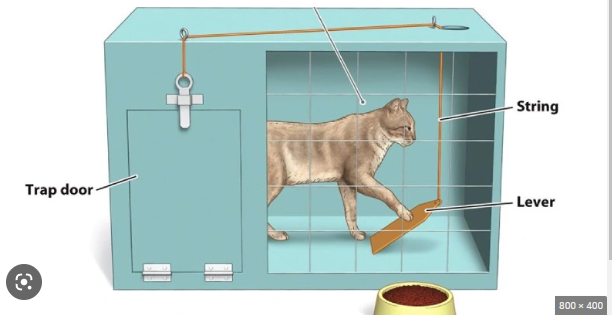
34
New cards
Law of Effect
Rewards are useful to get people/animals to do a wanted behavior
\
“Behavioral responses that were most closely followed by a satisfying result were most likely to become established patterns and to occur again in response to the same stimulus”
\
“Behavioral responses that were most closely followed by a satisfying result were most likely to become established patterns and to occur again in response to the same stimulus”
35
New cards
B. F. Skinner
this researcher put animals in Skinner boxes (which rewards animals for certain behavior)
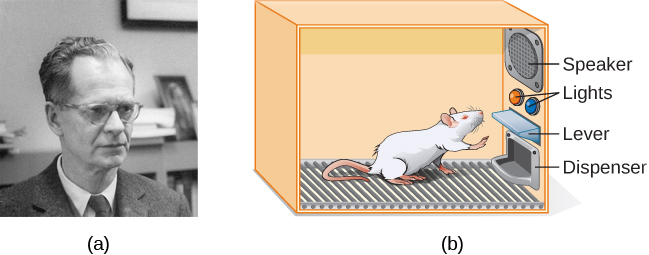
36
New cards
The Thorndike box was invented by E. L. Thorndike in the 1830s. The Skinner box came later and was considered an improvement in the device. Thus, it is the Skinner box that is the apparatus that has become the prototypical device for the controlled laboratory study of operant behavior.
\n The Skinner box also produces more accurate and useful results compared to Thorndike's puzzle box:
\
Skinner box lets you measure a number of successful responses on the part of the animal because the animal stays in the box and can push the lever (or other mechanism) many times to receive multiple rewards
On the other hand,
in a Thorndike box, an animal must escape from the box in order to earn its' reward. Once it is outside the box the experiment is over
\n The Skinner box also produces more accurate and useful results compared to Thorndike's puzzle box:
\
Skinner box lets you measure a number of successful responses on the part of the animal because the animal stays in the box and can push the lever (or other mechanism) many times to receive multiple rewards
On the other hand,
in a Thorndike box, an animal must escape from the box in order to earn its' reward. Once it is outside the box the experiment is over
What is the difference between the Skinner Box and Thorndike’s Puzzle Box?
37
New cards
Positive Reinforcement
A reward
38
New cards
Negative Reinforcement
A coping mechanism
“if you do \[the desired behavior\], then \[a bad thing does not happen\]”
\
ex. using an umbrella to avoid getting wet
ex. taking allergy medicine to avoid allergy symptoms
“if you do \[the desired behavior\], then \[a bad thing does not happen\]”
\
ex. using an umbrella to avoid getting wet
ex. taking allergy medicine to avoid allergy symptoms
39
New cards
Punishment
discourages bad behavior
40
New cards
Positive (Aversive) Punishment
a type of punishment where you ADD something you don’t want
ex. a speeding ticket
ex. getting hit with a ruler
ex. a speeding ticket
ex. getting hit with a ruler
41
New cards
Negative Punishment
a type of punishment where you withdraw something you like
ex. taking away a phone
ex. taking away a phone
42
New cards
Both types of reinforcement REINFORCE a good behavior while Punishment discourages a bad behavior.
What’s the difference between Positive/Negative Reinforcement vs. Punishment?
43
New cards
Premack Principle
In order to get better results, you must tailor the reward/punishment to your subject
\
ex. saying: “if you behave on the road trip, you will get chocolate” doesn’t work if your child doesn’t like chocolate
\
ex. saying: “if you behave on the road trip, you will get chocolate” doesn’t work if your child doesn’t like chocolate
44
New cards
Overjustification
Losing motivation for doing something that you used to do for free once you get rewarded for it
* decreases __implicit motivation__
\
ex. you love reading, but when school rewards reading, you start to think it’s a chore, so you like it less
* decreases __implicit motivation__
\
ex. you love reading, but when school rewards reading, you start to think it’s a chore, so you like it less
45
New cards
Primary Reinforcer
a reinforcer that automatically gives you pleasure
* nobody has to teach you that it is a good thing
\
ex. food, toy, hug
* nobody has to teach you that it is a good thing
\
ex. food, toy, hug
46
New cards
Secondary Reinforcer
a reinforcer that you have to learn has value
\
ex. money (a toddler would pick nickel over dime since it’s bigger, they haven’t learned the different values associated with each)
ex. grades (you have to learn the difference between an A and an F)
\
ex. money (a toddler would pick nickel over dime since it’s bigger, they haven’t learned the different values associated with each)
ex. grades (you have to learn the difference between an A and an F)
47
New cards
Continuous Reinforcement
a type of reinforcement where you get rewarded every time you do something
* you learn behavior fastest on __this schedule of reinforcement__
* but you also lose learned behavior the fastest in the absence of the reward
* you learn behavior fastest on __this schedule of reinforcement__
* but you also lose learned behavior the fastest in the absence of the reward
48
New cards
Partial Reinforcement
a type of reinforcement where you DON’T get rewarded every time you do something
* it takes longer to learn behavior
* but learned behavior stays longer
* it takes longer to learn behavior
* but learned behavior stays longer
49
New cards
Ratio Schedule
a type of *partial* reinforcement where the reward is based on # of behaviors
ex. for every 5 cars you sell, you get a reward
\
^^FIXED^^ ratio schedule:
ex. on a fixed ratio of 1:1, you get 1 reward for every 1 good behavior (this is AKA continuous reinforcement)
\
@@VARIABLE@@ ratio schedule:
ex. you “approximately” get a reward for every 5-ish cars
ex. this is like gambling, slots (it keeps effort up, because you never know when reward is coming)
ex. for every 5 cars you sell, you get a reward
\
^^FIXED^^ ratio schedule:
ex. on a fixed ratio of 1:1, you get 1 reward for every 1 good behavior (this is AKA continuous reinforcement)
\
@@VARIABLE@@ ratio schedule:
ex. you “approximately” get a reward for every 5-ish cars
ex. this is like gambling, slots (it keeps effort up, because you never know when reward is coming)
50
New cards
Interval Schedule
a type of *partial* reinforcement where the reward is based on duration of time
ex. paycheck every 2 weeks
\
^^FIXED^^ schedule:
* you are certain of intervals
ex. official paychecks
\
@@VARIABLE@@ interval schedule:
ex. allowance given by absent-minded parents (allowance given every friday-ish, so maybe given on Saturday or Sunday)
ex. paycheck every 2 weeks
\
^^FIXED^^ schedule:
* you are certain of intervals
ex. official paychecks
\
@@VARIABLE@@ interval schedule:
ex. allowance given by absent-minded parents (allowance given every friday-ish, so maybe given on Saturday or Sunday)
51
New cards
Shaping
training an individual to do a __complicated__ behavior
* reward is given step-by-step (reward given then withheld until next step is achieved)
\
ex. training service dogs
Step 1 = going to the refrigerator
no reward until…
Step 2 = opening the refrigerator
no reward until…
Step 3 = getting food
etc.
* reward is given step-by-step (reward given then withheld until next step is achieved)
\
ex. training service dogs
Step 1 = going to the refrigerator
no reward until…
Step 2 = opening the refrigerator
no reward until…
Step 3 = getting food
etc.
52
New cards
Even though they are both based on a reward system, the difference is the THINKING component
* cognitive learning does not require the same reinforcement that operant conditioning requires
Cognitive learning = your brain does the work of acquiring knowledge. Conditioned learning = your brain is not involved
* cognitive learning does not require the same reinforcement that operant conditioning requires
Cognitive learning = your brain does the work of acquiring knowledge. Conditioned learning = your brain is not involved
What is the difference between Cognitive Learning and Operant Conditioning?
\
\
53
New cards
Latent Learning
a type of learning where the learning of something is not apparent, it’s hidden until it is needed later (a suitable motivation and circumstances appear)
ex. David learning about Great Wall of China, but it’s not apparent until the topic came up in the waiting room
\
Unlike Operant conditioning, this shows that learning can occur without any reinforcement of a behavior.
ex. David learning about Great Wall of China, but it’s not apparent until the topic came up in the waiting room
\
Unlike Operant conditioning, this shows that learning can occur without any reinforcement of a behavior.
54
New cards
Tolman and rats with cognitive maps
Experiment
Experiment
Group 1: food reward every time they got out of maze successfully
Group 2: no food reward
Group 3: no food reward for first 10 days, but given incentive after
\
results:
group 3 rats took longer to reach end of maze during first 10 days b/c they didn’t have motivation, BUT they were the fastest out of all the rats after 10 days
they latently learned their way around the maze in first 10 days, but it didn’t become apparent until they were given a food incentive
Group 2: no food reward
Group 3: no food reward for first 10 days, but given incentive after
\
results:
group 3 rats took longer to reach end of maze during first 10 days b/c they didn’t have motivation, BUT they were the fastest out of all the rats after 10 days
they latently learned their way around the maze in first 10 days, but it didn’t become apparent until they were given a food incentive
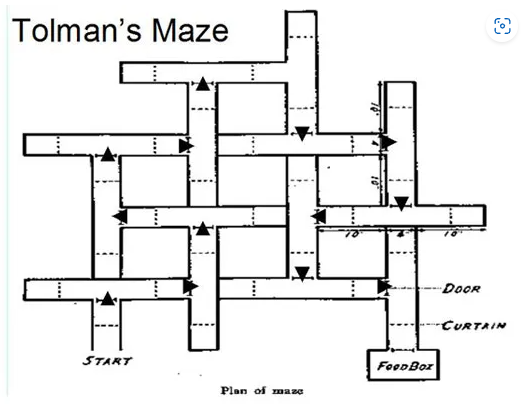
55
New cards
Cognitive Map
a mental representation of an external environment (feature/landmark)
56
New cards

Insight Learning
when you’re stuck on a problem until an answer suddenly appears
“AHA!”
usually solved as you let the problem “incubate”
\
ex. Kohler places food in unreachable places while chimps are nearby with tools, they eventually came to a cognitive understanding/solution
ex. chimps stack boxes on top of one another to get banana
“AHA!”
usually solved as you let the problem “incubate”
\
ex. Kohler places food in unreachable places while chimps are nearby with tools, they eventually came to a cognitive understanding/solution
ex. chimps stack boxes on top of one another to get banana
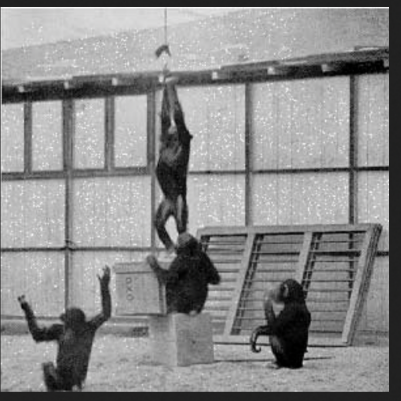
57
New cards
Learned Helplessness
learning that you can’t help yourself but transferring the assumption that you’re helpless to situations where you CAN escape the situation
\
ex. Seligman and shocked dogs who learn to give up even when there’s an exit
\
ex. Seligman and shocked dogs who learn to give up even when there’s an exit
58
New cards
Social (Observational) Learning
learning from others (directly or by observation)
59
New cards
Bandura and Bobo doll
kids learn to either beat up or play nice with doll (Bobo) by observing adults
Modeling: kids mimicked behavior of adults being violent or gentle
\+
Vicarious learning: kids watched film of others
* depending on whether adults rewarded or punished, kids either beat down or play nice with Bobo
Modeling: kids mimicked behavior of adults being violent or gentle
\+
Vicarious learning: kids watched film of others
* depending on whether adults rewarded or punished, kids either beat down or play nice with Bobo
60
New cards
Modeling
a type of social learning where you imitate role-models in your environment
61
New cards
Vicarious Learning
a type of social learning where
* a person indirectly learns how to behave through a medium (story, video, etc.)
* and they look at whether someone else receives a %%reward%% or ==punishment== for their behaviors
\
* a person indirectly learns how to behave through a medium (story, video, etc.)
* and they look at whether someone else receives a %%reward%% or ==punishment== for their behaviors
\
62
New cards
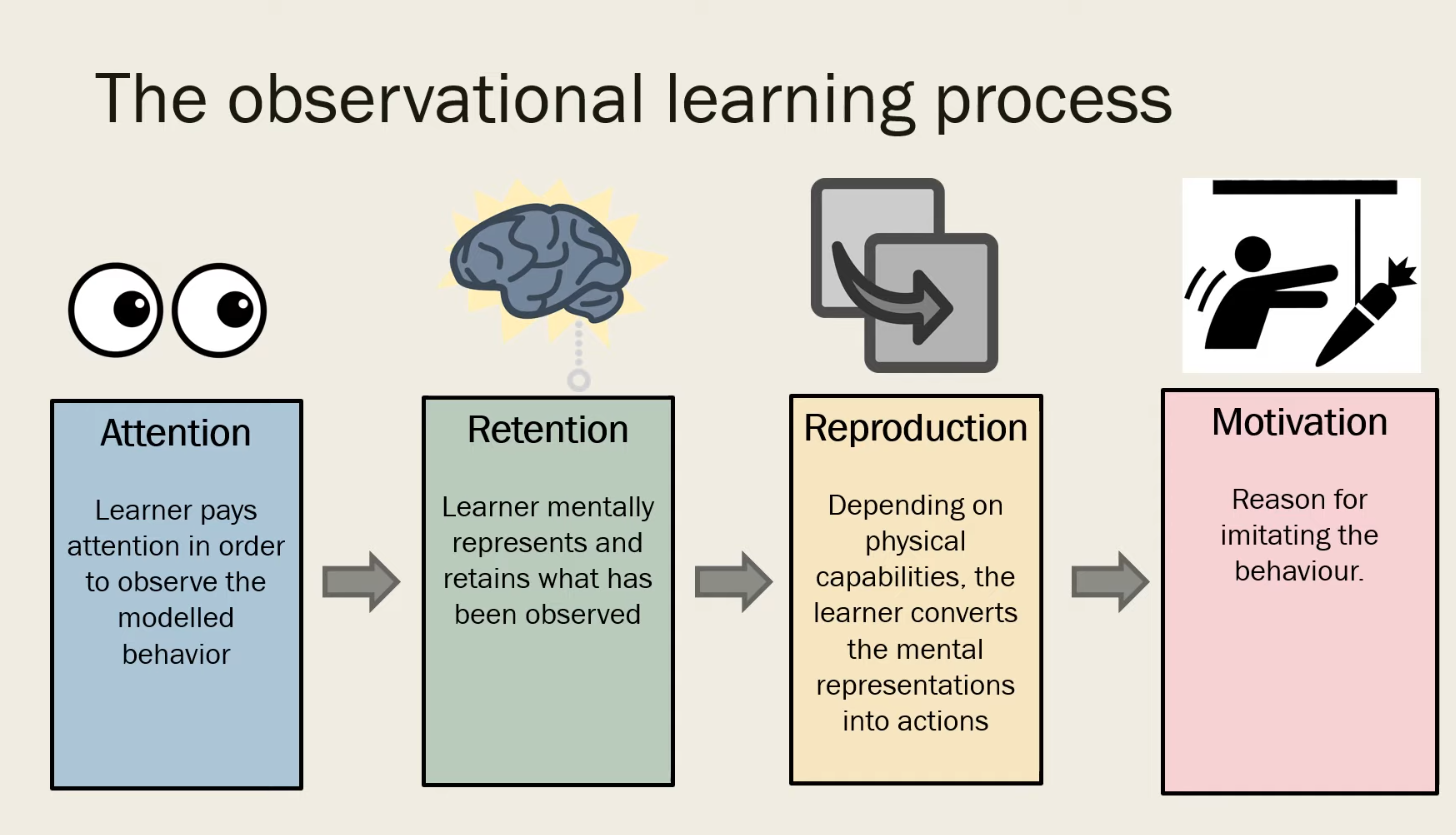
Attention
1st step of social learning = _____
\
learner pays attention in order to observe the modelled behavior
\
learner pays attention in order to observe the modelled behavior
63
New cards
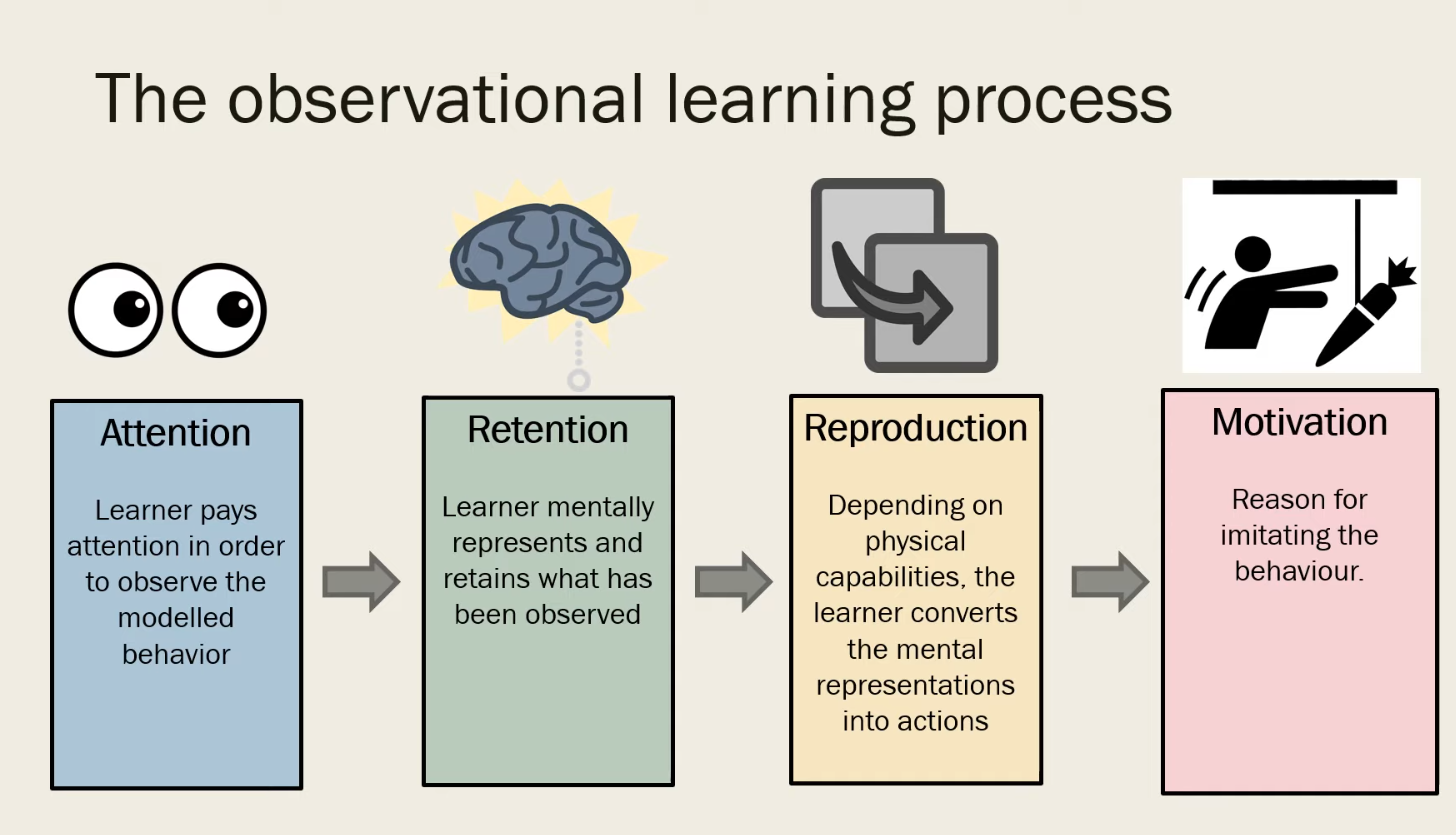
Retention
2nd step of social learning
Learner mentally represents and retains what has been observed (of both actions and their consequences)
Learner mentally represents and retains what has been observed (of both actions and their consequences)
64
New cards
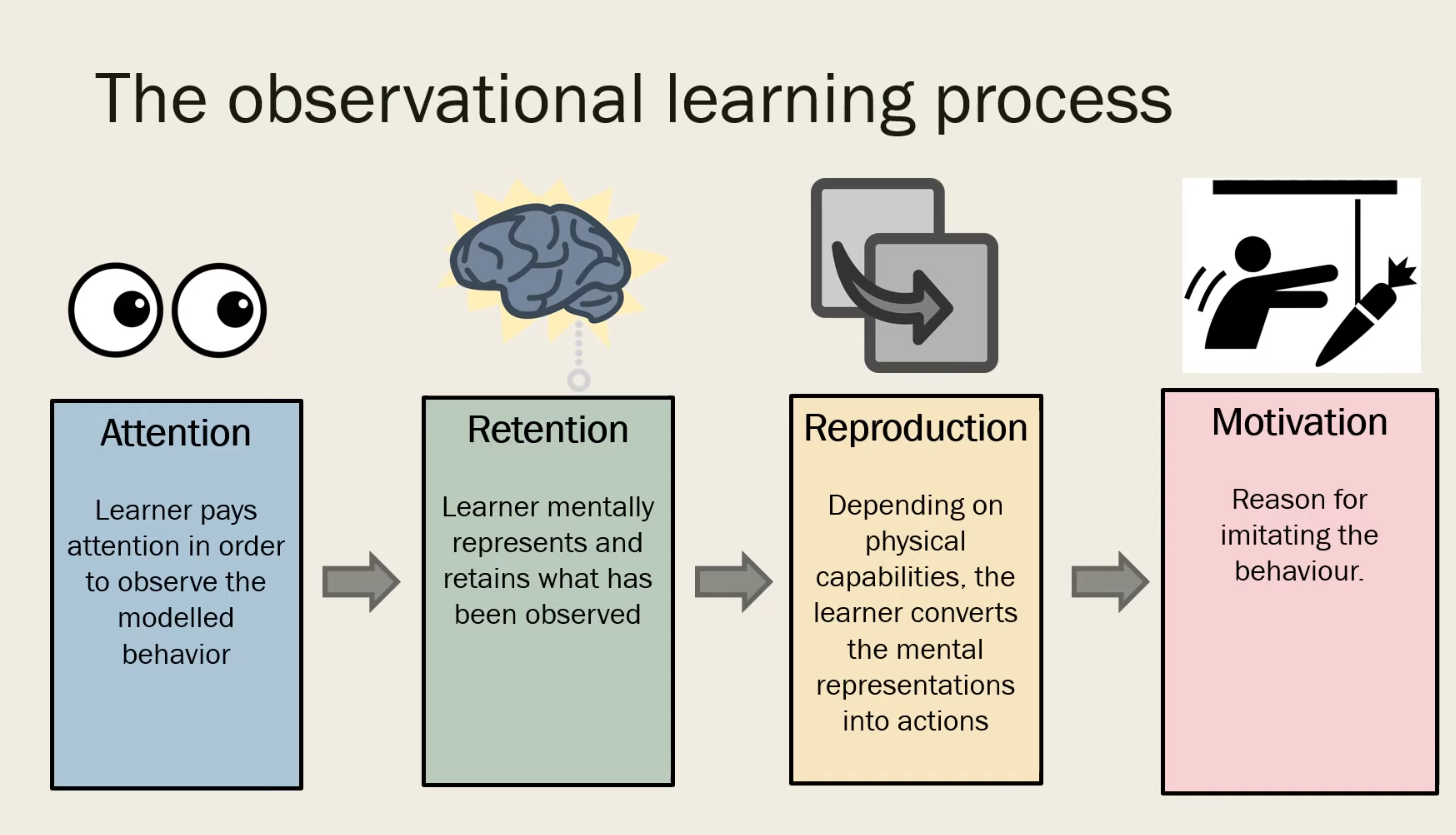
Reproduction
3rd step of social learning
Depending on physical capabilities, the learner converts the mental representations into actions
Depending on physical capabilities, the learner converts the mental representations into actions
65
New cards
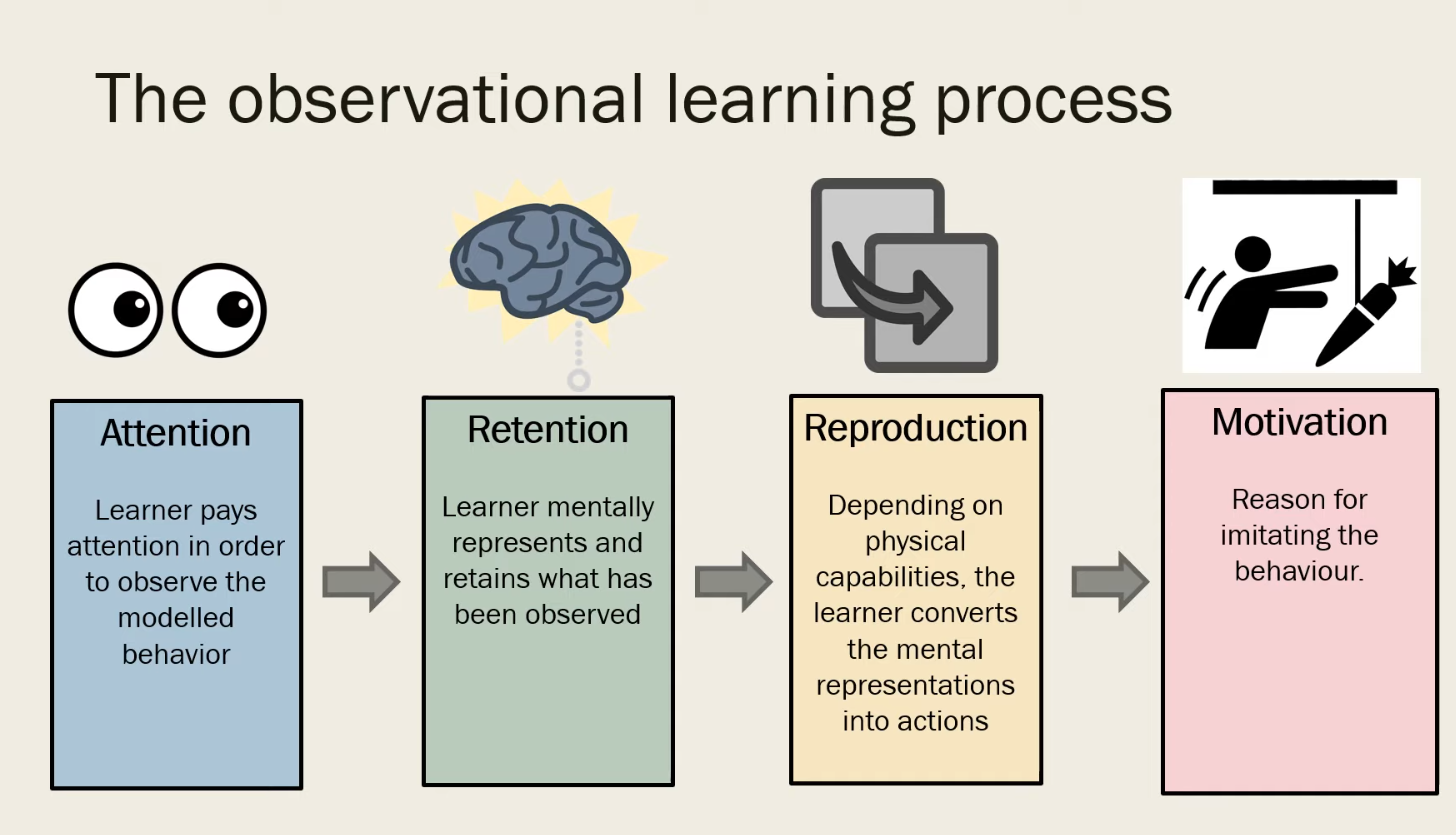
Motivation
4th step of social learning
Reason for imitating the behavior
Reason for imitating the behavior
66
New cards
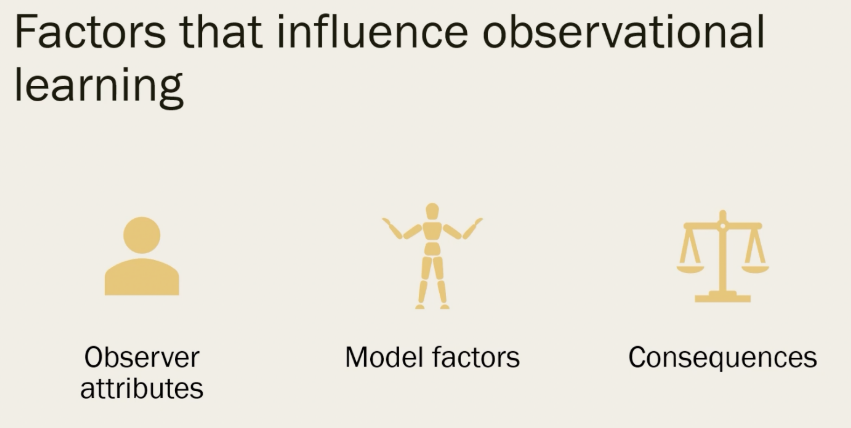
Factors that Influence Social Learning
* observer attributes
* model factors
* consequences
\
Observational learning - YouTube
* model factors
* consequences
\
Observational learning - YouTube
67
New cards
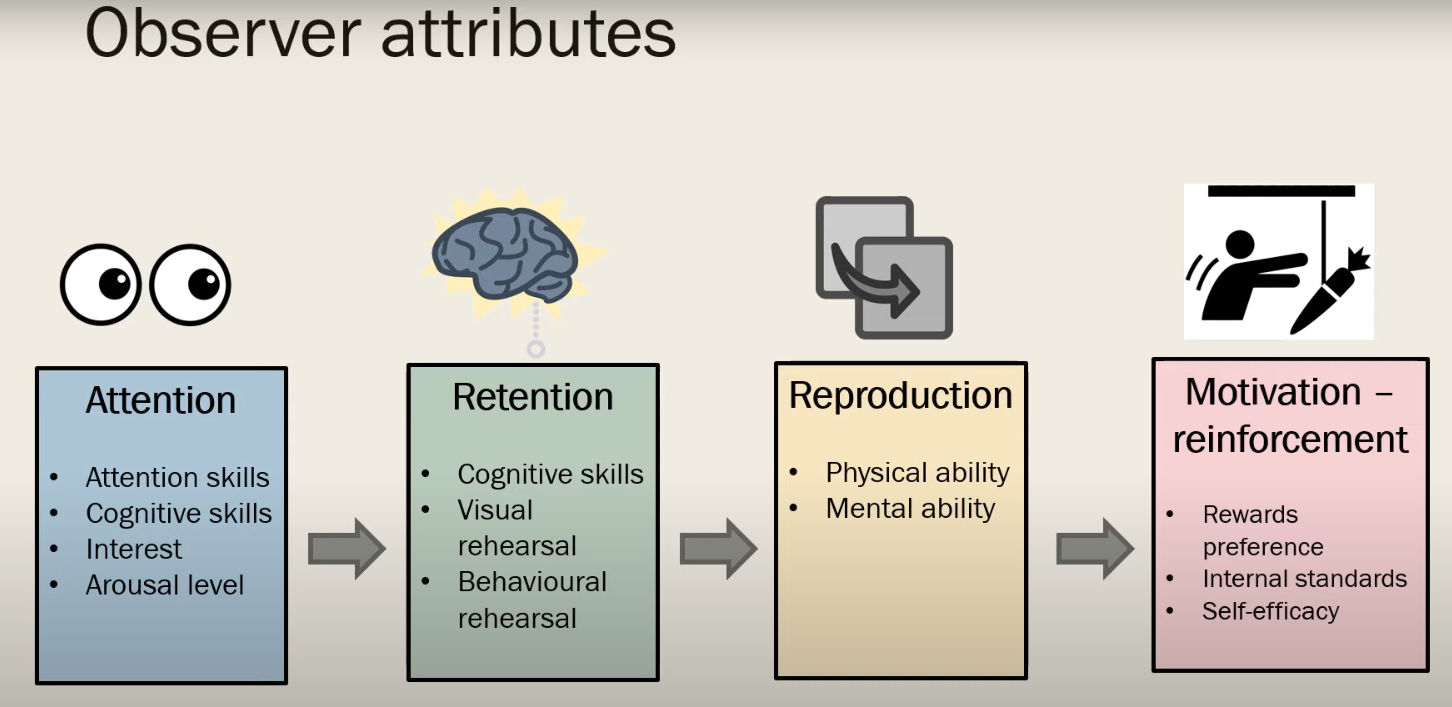
Observer Attributes
a factor of Social Learning that depends on the observer’s ability to pay attention, retain info, and physically/mentally reproduce the behavior. it also depends on their reward preference, internal standards and self-efficacy (the belief that they can do the behavior)
68
New cards
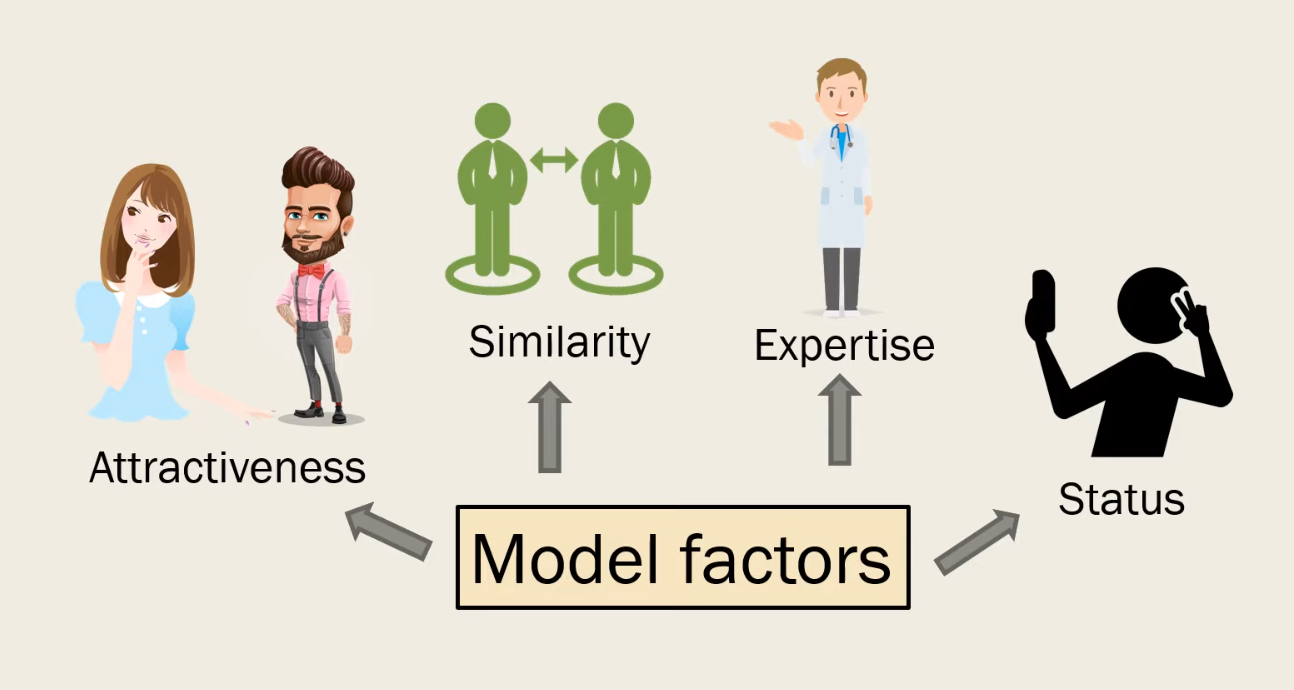
Model Factors
a factor of Social Learning that depends on the qualities of models
* attractiveness
* similarity to observer
* expertise
* status
* attractiveness
* similarity to observer
* expertise
* status
69
New cards
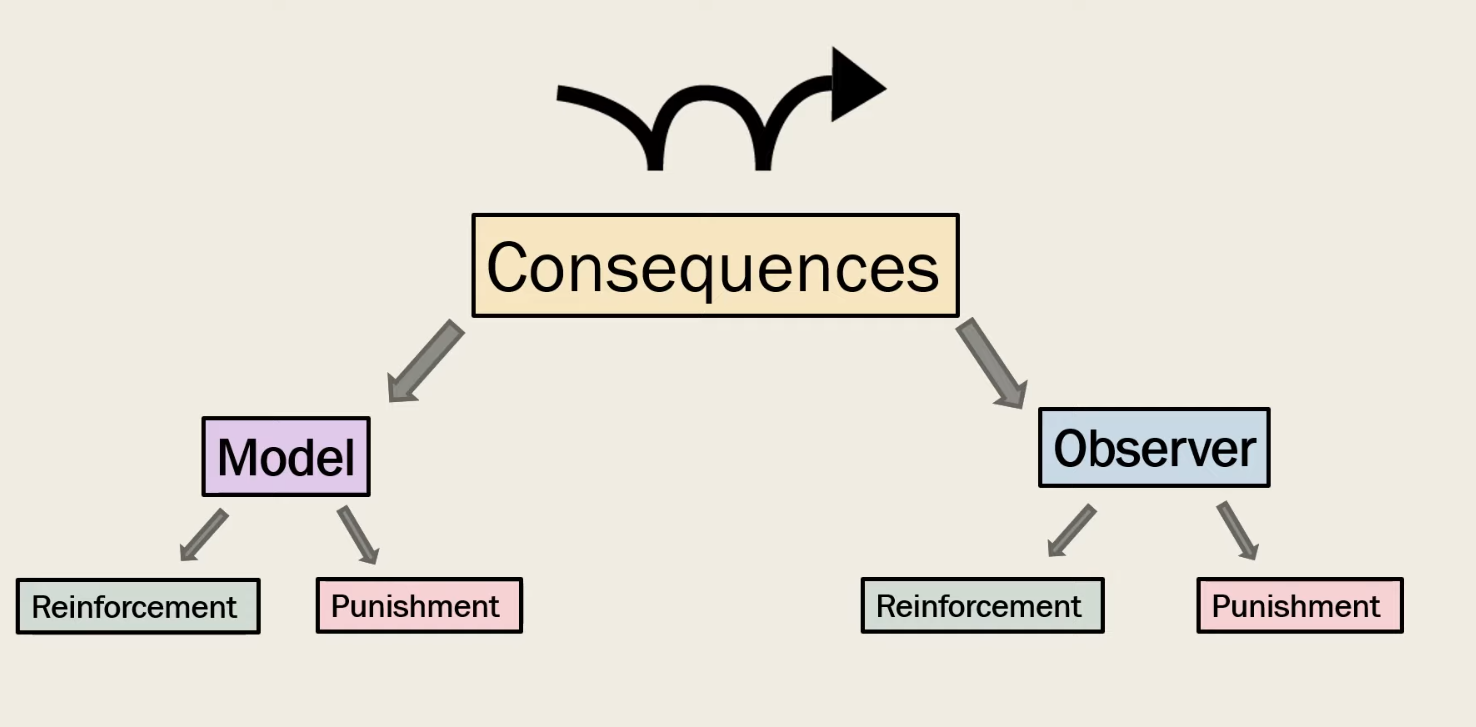
Consequences
a factor of Social Learning that depends on reinforcement or punishment received by the model and imitator
70
New cards
Mirror Neurons
a type of brain cell that respond equally when we perform an action and when we witness someone else perform the same action
\
* they provide a neural mechanism to understand actions, emotions, and intentions which is fundamental to social behavior
* strongly linked to our ability to show empathy
* also play a part in social learning
* help to interpret facial expressions
\
* they provide a neural mechanism to understand actions, emotions, and intentions which is fundamental to social behavior
* strongly linked to our ability to show empathy
* also play a part in social learning
* help to interpret facial expressions
71
New cards
Biofeedback
an operant conditioning technique that teaches people to gain voluntary control over bodily processes like heart rate and blood pressure
* helps you make subtle changes in your body, such as relaxing certain muscles, to achieve the results you want, such as reducing pain.
* helps you make subtle changes in your body, such as relaxing certain muscles, to achieve the results you want, such as reducing pain.